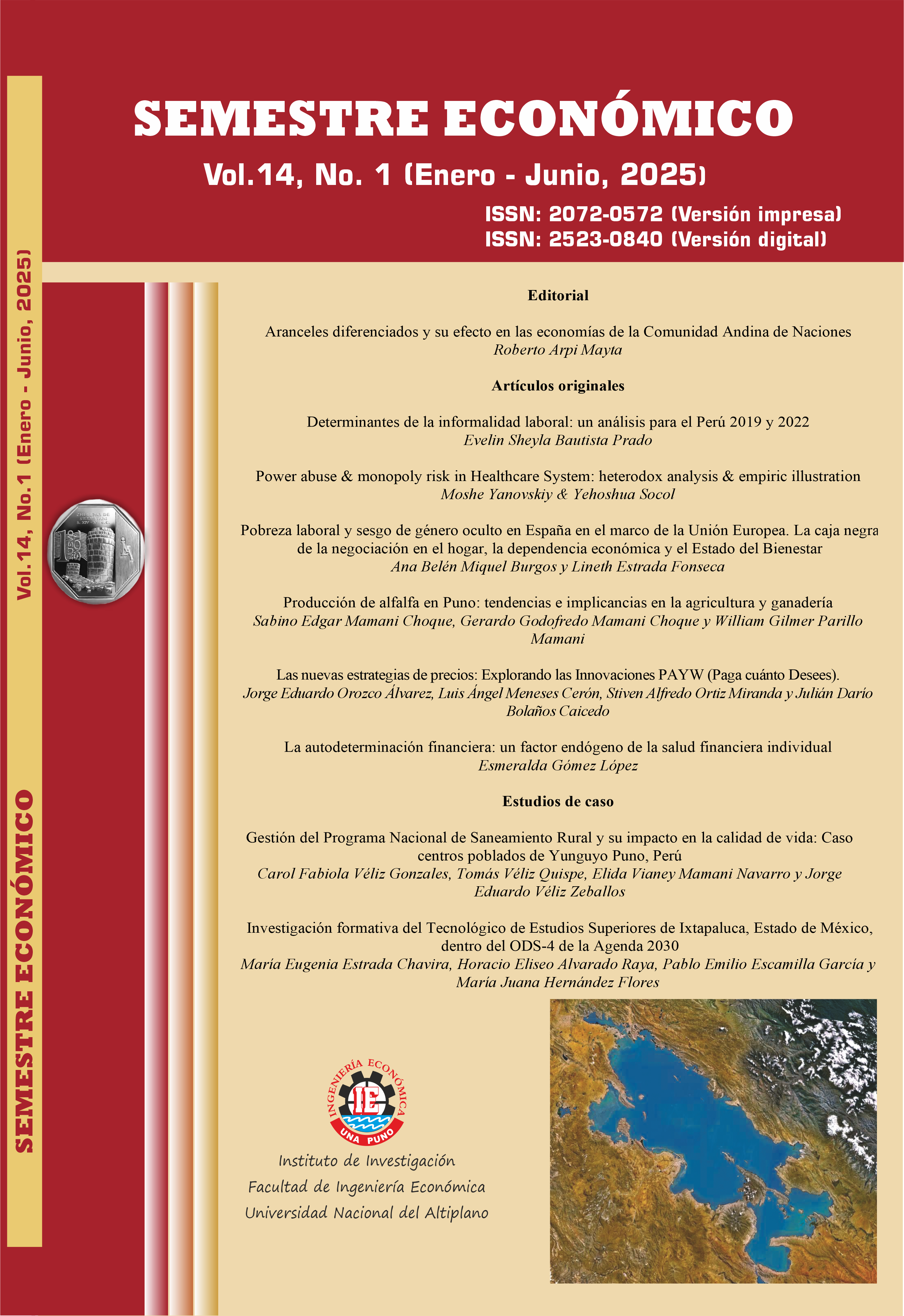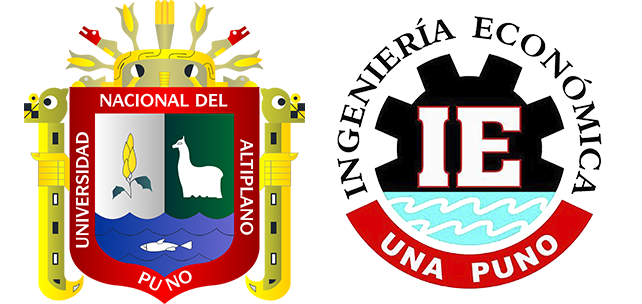Alfalfa Production in Puno: Trends and Implications for Agriculture and Livestock Farming
DOI:
https://doi.org/10.26867/se.2025.v14i1.181Keywords:
alfalfa, producción agropecuaria, adopción de tecnología, cambio climáticoAbstract
This research on alfalfa production in Puno analyzes the transformation of the regional agricultural structure during the last decades, highlighting the strategic role of this crop in the agricultural and livestock contexts. Based on data from the 1996/1997 to 2021/2022 agricultural campaigns, trends are identified such as the increase in the area destined for forage, driven by climate change and migration to mining activities. These changes have generated a shift from traditional crops to more resistant and profitable ones, such as alfalfa, which supports the growing dairy livestock activity. Techniques such as cluster analysis were used to classify districts according to production patterns and the Gompertz model to evaluate technological adoption. On the other hand, based on data from the 2012 National Agricultural Census, three agricultural groups were identified, characterized by levels of specialization and climatic adaptability. Furthermore, a sigmoid pattern was observed in the adoption of alfalfa, with slow initial growth that accelerated in recent years, consolidating it as a key crop. In conclusion, the need for policies that balance sustainability, productivity and resilience to climate and social challenges is highlighted.
Metrics
References
Altieri, M., & Nicholls, C. (2000). Agroecología. Teoría y práctica para una agricultura sustentable (1ra ed.). PNUMA.
Baraj, B., Mishra, M., Sudarsan, D., Silva, R. M. da, & Santos, C. A. G. (2024). Climate change and resilience, adaptation, and sustainability of agriculture in India: A bibliometric review. In Heliyon (Vol. 10, Issue 8). Elsevier Ltd. https://doi.org/10.1016/j.heliyon.2024.e29586
Boas, I., Farbotko, C., Adams, H., Sterly, H., Bush, S., van der Geest, K., Wiegel, H., Ashraf, H., Baldwin, A., Bettini, G., Blondin, S., de Bruijn, M., Durand-Delacre, D., Fröhlich, C., Gioli, G., Guaita, L., Hut, E., Jarawura, F. X., Lamers, M., … Hulme, M. (2019). Climate migration myths. Nature Climate Change, 9(12), 901–903. https://doi.org/10.1038/s41558-019-0633-3
Byerlee, D., Collinson, M., Perrin, R., Winklemann, D., Biggs, S., Moscardi, E., Martinez, J., Harrington, L., & Benjamin, A. (1980). Planning technologies appropriate to farmers: Concepts and procedures. CIMMYT, El Batan, Mexico, 71 pp.
Casas, G. A., Rodríguez, D., & Afanador Téllez, G. (2010). Propiedades matemáticas del modelo de Gompertz y su aplicación al crecimiento de los cerdos. Revista Colombiana de Ciencias Pecuarias, 23, 349–358.
Ccama, F. (1991). La estructura y evolución de la producción agropecuaria en el departamento de Puno: Periodo 1970-1988. Proyecto de Investigación de Sistemas Agropecuarios Andinos INIAA-PISA.
Chavas, J. P. (2001). Structural change in agricultural production: Economics, technology and policy. In Handbook of Agricultural Economics. Elsevier Science B.V.
Colton, J. S. (2015). Adoption, diffusion, and scaling of agricultural technologies in developing countries (pp. 45–75). https://doi.org/10.1007/978-3-319-21629-4_2
Dissanayake, C., Jayathilake, W., Wickramasuriya, H., Dissanayake, U., Kopiyawattage, K., & Wasala, W. (2022). Theories and Models of Technology Adoption in Agricultural Sector. In Human Behavior and Emerging Technologies (Vol. 2022). Wiley-Hindawi. https://doi.org/10.1155/2022/9258317
Escobar, G., & Berdegue, J. (1990). Tipificación de sistemas de producción agrícola. Red Internacional de Metodología de Investigación de Sistemas de Producción.
Franco, J., & Rodriguez, M. (2009). Adopción y difusión de la agricultura ecológica en España. Factores de reconversión en el olivar andaluz. Cuadernos de Economía, 32(90), 137–158.
Garrido Egido, L. (1969). Consideraciones en torno a la estructura agraria y su reforma. Revista de Estudios Agrosociales, 67, 63–84.
Gerencia Regional de Desarrollo Agrario. (n.d.). Información Estadística. Retrieved November 13, 2024, from https://www.agropuno.gob.pe/estadistica-agraria-informatica/
Goetz, J. M. (2022). What do we know about rural and informal non-farming labour? Evidence from a mixed methods study of artisanal and small-scale mining in Northwest Tanzania. World Development, 158. https://doi.org/10.1016/j.worlddev.2022.106012
Hair, J. F., Anderson, R. E., Tatham, R. L., & Black, W. C. (1999). Análisis multivariante (5ta.). Prentice Hall.
Instituto Nacional de Estadística e Informática [INEI]. (n.d.). Sistema de Consulta - IV Censo Nacional Agropecuario 2012. Instituto Nacional de Estadística e Informática - INEI.
Instituto Nacional de Estadística e Informática [INEI]. (2023). Compendio Estadístico Puno 2023. INEI. Https://Www.Gob.Pe/Institucion/Inei/Informes-Publicaciones/4134032-Compendio-Estadistico-Puno-2023.
Jabbar, M. A., Beyene, H., Saleem, M., & Gebreselassie, S. (1998). Adoption Pathways for New Agricultural Technologies: An Approach and an Application to Vertisol Management Technology in Ethiopia.
Kalaitzandonakes, N., Carayannis, E., Grigoroudis, E., & Rozakis, S. (2018). From agriscience to agribusiness Theories. Policies and practices in technology transfer and commercialization. http://www.springer.com/series/8124
Lartey, F. M. (2020). Predicting Product Uptake Using Bass, Gompertz, and Logistic Diffusion Models: Application to a Broadband Product. Journal of Business Administration Research, 9(2), 5. https://doi.org/10.5430/jbar.v9n2p5
León-Velarde, C., & Quiroz, R. (1994). Análisis de Sistemas Agropecuarios: Uso de métodos bio-matemáticos. CONDESAN (CIP-CIID-CIRNMA).
Lobell, D. B., & Gourdji, S. M. (2012). The Influence of Climate Change on Global Crop Productivity. Plant Physiology, 160(4), 1686–1697. https://doi.org/10.1104/pp.112.208298
López Rodríguez, S., van Bussel, L. G. J., & Alkemade, R. (2024). Classification of agricultural land management systems for global modeling of biodiversity and ecosystem services. Agriculture, Ecosystems & Environment, 360, 108795. https://doi.org/https://doi.org/10.1016/j.agee.2023.108795
Macdonald, J. M., Korb, P., & Hoppe, R. A. (2013). United States Department of Agriculture Farm Size and the Organization of U.S. Crop Farming. www.ers.usda.gov/topics/farm-economy/farm-structure-organization.aspx
Peña, D. (2002). Análisis de datos multivariantes. Mc Graw Hill.
Rogers, E. M. (1983). Diffusion of innovations (3ra. Ed.). Macmillan Co.
Rogers, E. M., Singhal, A., & Quinlan, M. M. (2019). Diffusion of innovations. In An Integrated Approach to Communication Theory and Research, Third Edition (pp. 415–433). Taylor and Francis. https://doi.org/10.4324/9780203710753-35
SAS Institute Inc. (2023). SAS. Https://Www.Sas.Com/Es_mx/Software/on-Demand-for-Academics.Html.
Solomon, D., Ishtiaque, A., Agarwal, A., Gray, J. M., Carmen Lemos, M., Moben, I., Singh, B., & Jain, M. (2024). The role of rural circular migration in shaping weather risk management for smallholder farmers in India, Nepal, and Bangladesh. Global Environmental Change, 89, 102937. https://doi.org/10.1016/j.gloenvcha.2024.102937
Sumner, D. A., Alston, J. M., & Glauber, J. W. (2010). Evolution of the Economics of Agricultural Policy. American Journal of Agricultural Economics, 92(2), 403–423. https://doi.org/10.1093/ajae/aaq015
Taonda, A., Zerbo, I., N’Guessan, A. E., Traoré, I. C. E., Kassi, J. N. ’Dja, & Thiombiano, A. (2024). Effects of land use and climate on the diversity and population structure in natural stands of Detarium microcarpum Guill. & Perr. (Fabaceae) in Burkina Faso (West Africa). Global Ecology and Conservation, 51. https://doi.org/10.1016/j.gecco.2024.e02909
Tatis Diaz, R., Pinto Osorio, D., Medina Hernández, E., Moreno Pallares, M., Canales, F. A., Corrales Paternina, A., & Echeverría-González, A. (2022). Socioeconomic determinants that influence the agricultural practices of small farm families in northern Colombia. Journal of the Saudi Society of Agricultural Sciences, 21(7), 440–451. https://doi.org/10.1016/j.jssas.2021.12.001
Van Den Bosch, M. E. (2020). Estructura agraria, transformaciones y procesos territoriales Una revisión conceptual. https://www.researchgate.net/publication/343720159
Williams, T. (1994). Identifying target groups for livestock improvement research: The classification of sedentary livestock producers in western Niger. In Agricultural Systems (Vol. 46).
Zerbo, I., Balima, L. H., Guuroh, R. T., & Thiombiano, A. (2024). Impact of climate, land management and harvesting patterns on the ecological traits and the population structure of Pterocarpus lucens in West African semi-arid areas. Environmental Challenges, 17. https://doi.org/10.1016/j.envc.2024.101012















